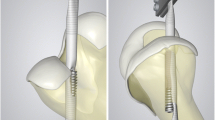Summary
The purpose of this study was to assess the effects of biodegradable interference screw use in ACL reconstruction beyond the usual clinical historical and physical findings. The use of this material for interference screws has potential benefits if the problems of inflammation are minimal and the fixation properties are sufficient. There is no need for a second operation for removal and no complicating factor if revision surgery is necessary. A prospective study was initiated in May, 1993 to evaluate the use of biodegradable interference screws (Instrument Makar). Our patients were evaluated with the aid of the common OAK-score. The overall evaluation showed 89.5 % excellent and good results, 7 % fair results and 3.5 % poor results. The average score was 90.7 points (63–100 points). The measurement with the arthrometer (KT 1000) showed a difference of up to 3 mm as compared to the knee joint not operated on in 24 (93 %) of the patients. Four patients showed a 3 to 6 mm difference. A tibia translation of more than 4 mm was not measured in any case. The biodegradable interference screw is a safe and effective interference screw for fixation of the bone blocks for ACL reconstruction.
Zusammenfassung
Ziel unserer prospektiven Studie war es, die funktionellen Ergebnisse nach vorderer Kreuzbandrekonstruktion unter Verwendung von biodegradierbaren Interferenzschrauben zu evaluieren. Die Evaluation erfolgte mittels des OAK-Score, dem KT-1000 Arthrometer und subjektiven Parametern. Die KT-1000-Untersuchung ergab bei 26 Patienten (92,8 %) eine Differenz bis zu 3 mm im Vergleich zum nicht operierten Kniegelenk. Einen Seitenunterschied von 3–4 mm stellten wir bei 2 Patienten fest. Eine Tibiatranslation von mehr als 4 mm wurde nie gemessen. Die Gesamtbeurteilung des OAK Score ergab 89,5 % sehr gute und gute Ergebnisse, 7 % mäßige Ergebnisse und 3,5 % schlechte Ergebnisse. Der durchschnittliche Gesamtscore betrug 90,7 (63–100) Punkte. Die Studie zeigt, daß die Fixation der Knochenblöcke von Lig.-patellae-Dritteln mit resorbierbaren Interferenzschrauben (Instrument Makar) eine sichere und effektive Methode ist, mit der sich gute Ergebnisse erzielen lassen.
Similar content being viewed by others
Author information
Authors and Affiliations
Rights and permissions
About this article
Cite this article
Lajtai, G., Humer, K., Aitzetmüller, G. et al. Results of anterior cruciate ligament reconstruction and the use of absorbable interference screws (minimum 2.5-year follow-up). Unfallchirurg 102, 35–42 (1999). https://doi.org/10.1007/s001130050370
Published:
Issue Date:
DOI: https://doi.org/10.1007/s001130050370




